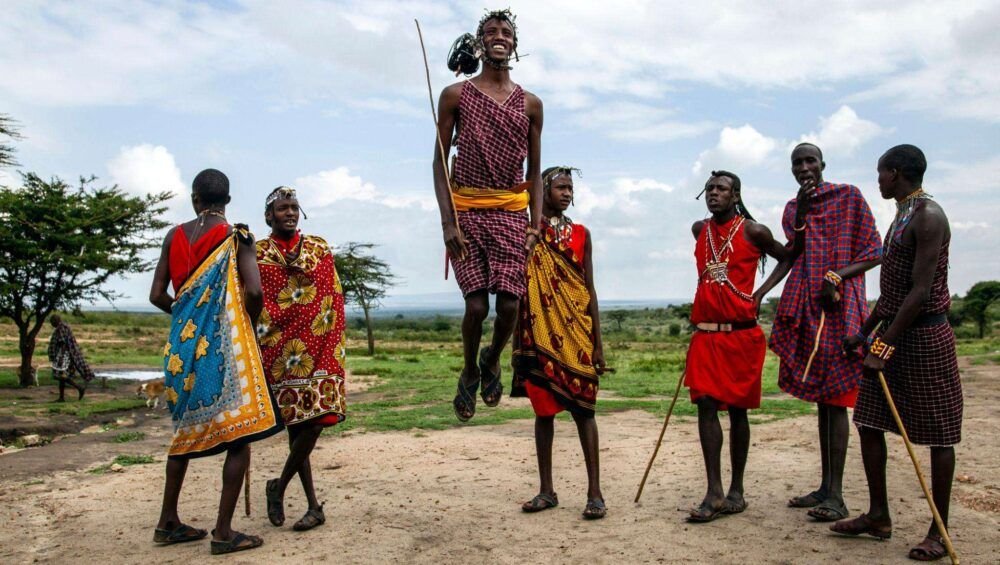Welcome to the Wild and Wonderful World of Tanzanian Safaris
Imagine starting your day as the sun rises over the vast plains of the Serengeti, casting golden hues over a landscape teeming with life. You’re on safari in Tanzania, arguably the ultimate destination for those in pursuit of both unparalleled wildlife encounters and rich cultural experiences. It’s a wild adventure spiced with the flavors of genuine human connection and discovery.
Now, you might ask, what makes a Tanzanian safari more than just a feast for the eyes? Well, it’s the rare blend of nature and culture that this East African jewel offers. Picture yourself not only spotting the Big Five during the day but also interacting with local tribes like the Maasai or Hadzabe in the evenings. It’s not merely about ticking animals off your bucket list but also opening your eyes to the diverse cultures that have thrived for centuries in harmony with nature. Isn’t it fascinating how cultures and landscapes coalesce here, like the colors in a Maasai shuka wrap?
Embracing Culture with Sensitivity
One thing I’ve learned from my travels is the profound importance of understanding and respecting local cultures, especially when venturing into someone else’s backyard. This isn’t just about being polite; it’s about enriching your own experience and being a responsible traveler. Just think of those moments when you connected deeply with someone from a far-flung place—it adds an irreplaceable depth to your journey, doesn’t it?
So, whether you’re watching a spellbinding Maasai dance under the stars or chatting with a Hadzabe hunter by the fire, remember that every interaction is an opportunity for growth and understanding—not just for you, but for the communities you visit. After all, meaningful connections can be as majestic as any wildlife sighting, and respecting them makes your safari not just an adventure, but a journey of cultural enlightenment.
Introduction to Tanzanian Safaris and Cultural Integration
Brief Overview of Tanzania as a Top Safari Destination in Africa
Picture this: you’re sipping a freshly brewed cup of coffee under the wide, open sky, while the sun paints the horizon in glorious shades of orange and pink. The rhythmic calls of the wild surround you, as a herd of elephants elegantly marches by. Welcome to Tanzania, a land where Mother Nature flaunts her most breathtaking wonders and where a safari experience like no other awaits you.
It’s no wonder Tanzania is often at the top of many adventurers’ bucket lists. With world-renowned parks like Serengeti National Park and Ngorongoro Crater, Tanzania offers unmatched wildlife viewing opportunities. Have you ever dreamed of witnessing the Great Migration? Or tracking the legendary Big Five in their natural habitat? Tanzania is not just a safari destination; it’s a calling for anyone intrigued by the untamed beauty of the animal kingdom.
Highlighting the Unique Combination of Wildlife Exploration and Cultural Immersion
But there’s more to a Tanzanian safari than just marveling at animals. It’s about stepping into a realm where cultural richness and wildlife exploration intertwine to create a truly holistic adventure. While the savannah teems with life of the natural kind, it’s equally vibrant with rich traditions, long-standing customs, and age-old stories brought to life by the indigenous tribes.
Think about this – what if you could go beyond just watching majestic lions roam? What if you could sit with a Maasai elder under the starlit sky, sharing stories passed down through generations? Or learn about the exceptional survival skills of the Hadzabe, who have thrived in harmony with their surroundings for eons? Tanzania offers not only the intrigue of animals but the wisdom of its people. Such treasures aren’t just seen in the landscape; they’re felt in the conversations, the dances, and the lives of those who call this incredible land home.
Importance of Understanding and Respecting Local Cultures While on Safari
When I first set foot on Tanzanian soil, I was struck not just by the stunning beauty around me, but by the richness of the cultures I encountered. As thrilling as a lion’s roar echoing in the night can be, sharing a laugh with a local guide or watching a community celebration were moments that gave my journey depth and soul.
Let’s be honest, isn’t it tempting to just marvel at the sights and sounds without pausing to understand the soil you tread on? However, it’s crucial for visitors to not only soak up the beauty but to also embrace the customs and beliefs of this incredible land. After all, wouldn’t the cheetah lose its essence if you only focused on its speed and not its grace?
Tourists who take the time to understand the cultural tapestry of Tanzania are rewarded with a richer experience. It’s about being gracious guests, mindful of local etiquette, open to learning, and respectful of traditions that may differ vastly from our own. Engaging with local customs isn’t just a courtesy; it’s an opportunity to leave a positive impact.
When we consciously choose to respect and learn from these cultural encounters, we nurture a bond of mutual respect and appreciation. And isn’t that what true travel is all about? Understanding another’s perspective, allowing ourselves to be humbled by their knowledge, and leaving with more than what we came with? On a Tanzanian safari, the memories of lions roaring might fade, but the warmth of a community’s hospitality and wisdom will linger long after.
So, as you prepare for your journey into this land of extraordinary wildlife and vibrant cultures, remember to open your heart and mind to the stories, the people, and the lessons they generously offer. Not only will this enrich your own journey, but it will ensure that the cultural heritage of Tanzania continues to thrive for generations to come.

Exploring Local Tribes and Traditions
Picture yourself stepping out of your safari jeep, the dust of the Serengeti clinging to your boots, as you’re greeted by the vibrant colors and warm smiles of the Maasai community. If you’ve ever wondered what it feels like to truly immerse yourself in another culture, engaging with Tanzania’s local tribes is an experience not to be missed.
The Maasai: Guardians of the Savanna
The Maasai tribe is synonymous with the Tanzanian safari experience. You might be familiar with their striking red shukas (cloaks) and vivid beadwork, but there’s so much more to this community beyond their iconic attire. The Maasai are semi-nomadic herders, and their lives revolve around cattle, which are not just central to their economy but also to their social and spiritual life. The plains they walk have been nurturing their cattle and their culture for centuries.
One of my most memorable safari days involved participating in a Maasai cultural tour. Have you ever joined a traditional dance? The Morans (young warriors) leap into the air with a grace that defies gravity. You might find yourself awkwardly attempting to match their height and rhythm—a futile but fun task. During these performances, stories and traditions are shared in the form of song and dance. It’s a reminder that storytelling is a universal language.
The Hadzabe: Echoes of the Ancients
On the other side of the cultural spectrum are the Hadzabe, a small tribe of hunter-gatherers living near Lake Eyasi. With a population of around 1,200, they embody a way of life that has largely remained unchanged for thousands of years. If you’re thinking Flintstones, you’re a bit off, but the connection to our distant ancestors is palpable.
Imagine waking up at dawn to join the Hadzabe on a hunt. It’s not just a tourist attraction; it’s a window into a lifestyle that relies on skill and deep knowledge of the environment. The bow and arrow become extensions of the hunter, and you quickly learn there’s an art to it that’s honed over a lifetime.
Back at camp, the tribe invites you to partake in traditional stories; there’s a rhythm to their language that makes each tale as much about listening as it is about understanding. You’ll find kids mimicking their elders, learning the lore that has been passed down around countless campfires.
Opportunities for Cultural Engagement
So, how can you engage with these tribes beyond just observing? Many safari tours now offer hands-on cultural experiences. You can try your hand at beading with Maasai women, each bead and pattern telling a story of its own. Not only is it therapeutic, but you’ll walk away with a truly unique souvenir, crafted by your own hands.
Or perhaps you’re more inclined towards listening? Gather under a canopy of stars for an evening storytelling session, where you’ll learn about the echoes of ancient ways that still permeate these communities. It’s one thing to read about these traditions in a book, but quite another to hear them firsthand, feeling the intonation and emotion conveyed in their native tongue.
Supporting Indigenous Communities
Now, let’s tackle an important question: What impact does your visit have on these communities? Cultural tourism can be a double-edged sword. When managed responsibly, it offers a means for tribes to preserve their traditions, promoting pride in their heritage and generating income that supports their way of life. I personally found it reassuring to see cultural guides explaining how the funds from tourism contribute directly to community projects such as schools and clinics.
However, it’s crucial to approach these experiences with respect and humility. Engaging with these tribes should never feel like a human zoo; it’s about mutual exchange and understanding. The best approach? Ask questions, learn with an open heart, and tread lightly—both literally and figuratively.
As someone who’s witnessed the vibrant dynamics between culture and tourism in Tanzania, I can tell you that when done right, it enriches both the visitor and the host tremendously. So, when you plan your Tanzanian adventure, remember that a safari is not only about the lions and the elephants. It’s about the stories and lives that stitch together the intricate canvas of the Tanzanian wilderness.
Historical and Archaeological Sites
Imagine journeying back in time, thousands of years ago, to the beginnings of human history. That’s precisely what you can experience when visiting Tanzania’s historical and archaeological marvels. When on a Tanzanian safari, the wildlife is truly just one part of the adventure. Understanding the roots of human civilization adds a fascinating, deeper layer to your trip.
Key Sites for Deeper Historical Context
First on the must-visit list is the Olduvai Gorge. Known as the Cradle of Mankind, this site is pivotal for anyone fascinated by anthropology and history. Have you ever watched a documentary on early human evolution? Chances are, they mentioned Olduvai Gorge. Here, some of the oldest human fossils were discovered, including Homo habilis, an ancient ancestor of ours. It’s one thing to read about these findings in a textbook, but standing where our ancestors once walked is an experience that transforms history from abstract to personal.
Then there’s the Kondoa Rock-Art Sites, a UNESCO World Heritage Site. When you see these beautiful and enigmatic drawings etched into rock surfaces, it’s hard not to feel a sense of awe. The art dates back to over 2,000 years ago, depicting scenes of daily life, rituals, and the rich wildlife that artists likely admired. It’s a silent dialogue with the past, showcasing the early expressions of our collective human culture. How can you not be intrigued by that?
Glimpses into Ancient Human History
Exploring these sites isn’t just about marvelling at bones or deciphering ancient artwork; it’s about connecting with a timeline far greater than our individual lifespans. At Olduvai Gorge, visitors are often impressed not only by the artifact exhibits but also by the knowledgeable guides who are eager to share stories and insights gathered from years, even decades, of research. Engaging with these experts—who often have their own stories of discoveries—is not just educational; it can feel like you’ve stumbled into an archaeological expedition. Who knew learning could feel so adventurous?
At Kondoa, the vivid depictions of hunters, wild animals, and mystical symbols give an intriguing look at prehistoric life. They serve as cultural threads linking modern Tanzanian society to its ancient roots. Standing in front of these images can evoke a sort of kinship with the artists from millennia past. How did they create such fluid, lifelike art with primitive tools? Was it a hobby, or was it more spiritual? These are the questions that swirl in your mind as you take it all in.
Responsible Enjoyment and Learning
While it’s incredibly exciting to explore these historical sites, it’s important to do so responsibly. These sites need to be treated with the utmost respect to preserve them for future generations. That means following designated paths, not touching sensitive artifacts, and of course, leaving no trace of your visit behind—other than perhaps a few new thoughts and a lot of awe.
When visiting these sites, consider hiring a local guide. They not only enhance your understanding with in-depth knowledge and local lore but also help boost the local economy by involving communities in tourism. We’ve all been guilty at some point of skimming past plaques or information boards, but with a guide, every rock, every fossil comes with a rich story you won’t find online.
Lastly, capture memories mindfully. Sure, it’s tempting to snap endless photos, especially when there’s so much wonder around. But sometimes pausing, unplugging from technology, and just absorbing the moment can be far more enriching.
Embarking on a Tanzanian safari with a lens on historical and archaeological exploration undoubtedly enriches your cultural experience. Not only do you walk away with a deeper insight into human history’s vast panorama, but you also gain perspectives that resonate on a profoundly personal level. After all, these aren’t just any sites—they’re where parts of your own story, our shared human story, began.
Authentic Culinary Experiences
Alright, let’s dig into the delicious world of Tanzanian cuisine! Imagine this: you’ve spent the day exploring the wild, breathtaking landscapes of the Serengeti, and now it’s time to reward yourself with some local flavors. Tanzanian food is like a vibrant tapestry, woven with tastes and traditions from various regions and cultures. It’s not just about filling your belly; it’s about embarking on yet another journey—this time of the taste buds! Isn’t that what travel is all about?
A Taste of Tanzania
When it comes to food, Tanzania doesn’t hold back. From the earthy spices of the northern highlands to the coastal influences of the Swahili coast, every bite tells a story. For instance, have you ever tried ugali? This staple dish, beloved across East Africa, is a hearty maize-based accompaniment that’s ideal for soaking up savory stews. I once spent an afternoon trying to master its preparation in a tiny kitchen in Arusha. It seemed so simple at first, but achieving the right consistency is truly an art!
And then there’s Zanzibar’s spicy, aromatic pilau and biryani, brimming with exotic spices that reflect the island’s history as a bustling trade hub. Add some fresh-caught fish or juicy coconut chicken to the mix, and you’re in for a tropical treat!
Cooking Classes: Where the Real Magic Happens
Here’s the thing: sampling local dishes is wonderful, but learning to cook them? That’s the real deal. Cooking classes in Tanzania offer a hands-on approach to cultural immersion, allowing you to get your hands dusty with maize flour and sticky with spice-infused sauce. Picture this: you’re in a bustling local market, selecting fresh ingredients under the guidance of a knowledgeable chef. The air is thick with the chatter of vendors and the tantalizing aroma of fresh herbs. Can you already hear the sizzle of the frying pan?
These classes are more than just culinary tuition—they’re a masterclass in tradition and hospitality. I remember once struggling to peel the tiniest, most frustrating clove of garlic, simultaneously being teased and encouraged by my teacher. It’s experiences like these that teach you far more than any recipe book ever could.
Food as a Gateway to Cultural Understanding
You see, food is an excellent story-teller. It carries the narratives of the people who cook it, the places it comes from, and the journeys it undertakes. Tasting Tanzanian dishes, you’re not only savoring flavors—you’re tasting the culture, history, and essence of a nation. Isn’t that a fantastic way to connect with a place?
For example, when you bite into a juicy mishkaki (Tanzanian-style kebab), you’re experiencing the influence of Indian and Arab traders who brought their culinary traditions to the Swahili coast. Or when you slurp up a bowl of supu (local soup) with a group of friends under the warm, Tanzanian night sky, you’re tasting not just food, but community, warmth, and shared stories.
The Role of Food in Enhancing Visitor Satisfaction
Tellingly, food can make or break a visitor’s experience. After all, every meal is an opportunity to discover something new. How often have you found a new favorite dish when traveling? The thrill of wandering off the beaten path and stumbling upon a hidden gem of a restaurant is one of the many joys of travel. And in Tanzania, there are plenty of delicious surprises to be found.
Imagine returning from your safari adventure and finding a table spread with Kuku Paka, a rich coconut curry that fills the air with its tantalizing aroma. Or perhaps it’s the perfectly grilled nyama choma (roasted meat) that’s caught your fancy. Pair these with a local brew, and you’ve got yourself a culinary delight worth writing home about.
Trust me, the way to a traveler’s heart is through their stomach. I once met a traveler who claimed the simplest mandazi (Swahili doughnut) was the highlight of their trip! So, as you embark on your safari, remember—half the adventure lies in what you eat.
Incorporating local food not only completes the safari experience, but also leaves travelers with a deeper appreciation of the culture and a unique story to share. The memories of extraordinary wildlife viewed against the backdrop of Tanzanian landscapes, combined with the flavors that danced upon your palate, are bound to be a tale for the ages.
Conclusion: Embracing the Essence of Tanzania
As our journey across the Tanzanian landscape draws to a close, it becomes abundantly clear that a safari here is about so much more than witnessing majestic animals in their natural habitat. It’s about immersing oneself in a symphony of cultural and historical narratives that resonate throughout the vast plains and bustling towns.
Imagine standing shoulder to shoulder with a Maasai warrior, learning not just how they’ve honed their survival skills on the savannah, but also about their deep-rooted traditions and vibrant art forms. Or picture a moment when an elder from the Hadzabe tribe shares stories beneath a starlit sky, stories that have been passed down through generations and are alive with the whispers of ancient wisdom. How often do we get the privilege to look into a window as both a guest and a student, learning from living treasures of history?
Then there’s the awe of walking through corridors of time at places like Olduvai Gorge, a cradle of human history, where the footprints of our ancestors invite us to reflect on our shared journey as human beings. These landmarks are not just stones and relics; they’re intimate pieces of a grand narrative that enrich our understanding of what it means to truly be human.
And let’s not overlook the joy of tasting Tanzania! The food here isn’t just sustenance; it’s a feast for the senses that brings people together. Sampling local dishes and crafting them in a cooking class allows us to connect in a language that’s universally delicious.
So, dear traveler, as you pack your bags and prepare to return home, consider what you’ve gained: insights into a world where nature and culture dance in harmony, memories of extraordinary encounters, and perhaps a fresh perspective on your own cultural roots. It’s not just about what you’ve seen—it’s about what you’ve felt, tasted, and learned. A Tanzanian safari is an open invitation to not only explore with the eyes but to engage fully with the heart. Wouldn’t you agree it’s a journey truly worth taking?






